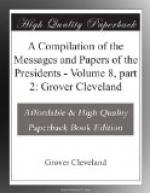The treaty, too, is recommended by the liberality of its provisions. The cession contained in the first article embraces the right, title, and interest secured to “the Six Nations of the New York Indians and St. Regis tribe” in lands at Green Bay by the Menomonee treaty of 8th February, 1831, the supplement thereto of 17th of same month, and the conditions upon which they were ratified by the Senate, except a tract on which a part of the New York Indians now reside. The Menomonee treaty assigned them 500,000 acres, coupled with the original condition that they should remove to them within three years after the date of the treaty, modified by the supplement so as to empower the President to prescribe the term within which they should remove to the Green Bay lands, and that if they neglected to do so within the period limited so much of the land as should be unoccupied by them at the termination thereof should revert to the United States. To these lands the New York Indians claimed title, which was resisted, and, for quieting the controversy, by the treaty of 1831 the United States paid a large consideration; and it will be seen that by using the power given in the treaty the Executive might put an end to the Indian claim. Instead of this harsher measure, for a grant of all their interest in Wisconsin, which, deducting the land in the actual occupancy of New York Indians, amounts to about 435,000 acres, the treaty as amended by the Senate gives 1,824,000 acres of lands in the West and the sum of $400,000 for their removal and subsistence, for education and agricultural purposes, the erection of mills and the necessary houses, and the promotion of the mechanic arts. Besides, there are special money provisions for the Cayugas, the Onondagas, the Oneidas of New York, the Tuscaroras, and St. Regis Indians, and an engagement to receive from Ogden and Fellows for the Senecas $202,000; to invest $100,000 of this sum in safe stocks and to distribute $102,000 among the owners of improvements in New York according to an appraisement; to sell for the Tuscaroras 5,000 acres of land they hold in Niagara County, N.Y., and to invest the proceeds, exclusive of what may be received for improvements, “the income from which shall be paid to the




